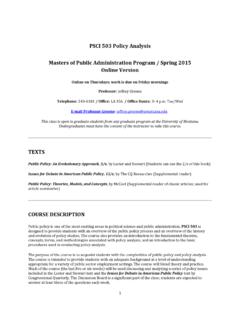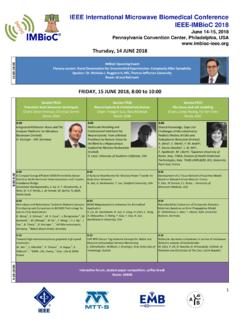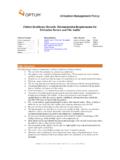Transcription of THE USE OF PROGRAM EVALUATION AND REVIEW …
1 A a a a ! "# $# % & ' ( ) # &( * (+ ," # - ( % $ % ! ' #$ (. ( This article is based on the research made in the international project Leonardo da Vinci SK/06/B/F/PP-177443 Vocational Education and Training for Quality of Life through e-HealthCare & Well Being / a 0a Academy of Economic Studies Faculty of Management Bucharest Romania s a PROGRAM EVALUATION and REVIEW Technique (PERT) is a project management tool used to schedule, organize, and coordinate tasks within a project. It is basically a method to analyze the tasks involved in completing a given project, especially the time needed to complete each task, and to identify the minimum time needed to complete the total project.)))))
2 PERT planning involves the following steps: 1. Identify the specific activities and milestones. 2. Determine the proper sequence of the activities. 3. Construct a network diagram. 4. Estimate the time required for each activity. 5. Determine the critical path. 6. Update the PERT chart as the project progresses. 2 34 5s6 PERT, PROGRAM EVALUATION and REVIEW Technique, nodes, PERT event, predecessor event, successor event, PERT activity, Optimistic time, Pessimistic time, Most likely time, Expected time, Critical Path, Lead time, Lag time, Slack. PROGRAM EVALUATION and REVIEW Technique (PERT) is a project management tool used to schedule, organize, and coordinate tasks within a project.
3 It is basically a method to analyze the tasks involved in completing a given project, especially the time needed to complete each task, and to identify the minimum time needed to complete the total project. The main objective of PERT is to facilitate decision making and to reduce both the time and cost required to complete a project. ! 5 0 a a PERT is intended for very large-scale, one-time, non-routine, complex projects with a high degree of intertask dependency, projects which require a series of activities, some of which must be performed sequentially and others that can be performed in parallel with other activities.
4 S PERT planning involves the following steps that are described below 78 (5 03 9 s 0 a : s a 5 s s8 The activities are the tasks required to complete a project. The milestones are the events marking the beginning and the end of one or more activities. It is helpful to list the tasks in a table that in later steps can be expanded to include information on sequence and duration. 8 ) 9 s ; 0 9 a : s8 This step may be combined with the activity identification step since the activity sequence is evident for some tasks. Other tasks may require more analysis to determine the exact order in which they must be performed.
5 <8 s a 4 = 5 a a 8 Using the activity sequence information, a network diagram can be drawn showing the sequence of the serial and parallel activities. Each activity represents a node in the network, and the arrows represent the relation between activities. Software packages simplify this step by automatically converting tabular activity information into a network diagram. a a a a >8 s a 9 ; 5 0 a 9 a : 38 Weeks are a commonly used unit of time for activity completion, but any consistent unit of time can be used. A distinguishing feature of PERT is its ability to deal with uncertainty in activity completion time.
6 For each activity, the model usually includes three time estimates: . Optimistic time generally the shortest time in which the activity can be completed. It is common practice to specify optimistic time to be three standards deviations from the mean so that there is a approximately a 1% chance that the activity will be completed within the optimistic time. Most likely time the completion time having the highest probability. Note that this time is different from the expected time. Pessimistic time the longest time that an activity might require.
7 Three standard deviations from the mean is commonly used for the pessimistic time. PERT assumes a beta probability distribution for the time estimates. For a beta distribution, the expected time for each activity can be approximated using the following weighted average: Expected time = ( Optimistic + 4 x Most likely + Pessimistic ) / 6 This expected time may be displayed on the network diagram. To calculate the variance for each activity completion time, if three standard deviation times were selected for the optimistic and pessimistic times, then there are six standard deviations between them, so the variance is given by: [ ( Pessimistic - Optimistic ) / 6 ] 5.
8 9 a a 98 The critical path is determined by adding the times for the activities in each sequence and determining the longest path in the project. The critical path determines the total calendar time required for the project. If activities outside the critical path speed up oe slow down (within limits), the total project time does not change. The amount of time that a non critical path activity can be delayed without the project is referred to as a slack time. If the critical path is not immediately obvious, it may be helpful to determine the following four quantities foe each activity: ES Earliest Start time EF - Earliest Finish time LS Latest Start time LF - Latest Finish time These times are calculated using the expected time for the relevant activities.
9 The earliest start and finish times of each activity are determined by working forward through the network and determining the earliest time at which an activity can start and finish considering its predecessors activities. The latest start and finish times are the latest times that an activity can start and finish without delaying the project. LS and LF are found by working backward through the network. The difference in the latest and earliest finish of each activity is that activity s slack. The critical path then is the path through the network in which none of the activities have slack.
10 The variance in the project completion time can be calculated by summing the variances in the completion times of the activities in the critical path. Given this variance, one can calculate the probability that the project will be completed by the certain date assuming a normal probability distribution for the critical path. The normal distribution assumption holds if the number of activities in the path is large enough for the central limit theorem to be applied. a a a a Since the critical path determines the completion date of the project, the project can be accelerated by adding the resources required to decrease the time for the activities in the critical path.









